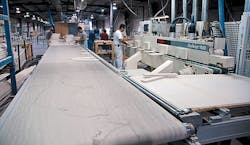Houston’s notoriously high humidity was causing problems for Kent Moore Cabinets Ltd., a small manufacturer of kitchen, bath and entertainment center cabinetry.
The company, based in the central-Texas city of Bryan, ships its products to in-state markets including the Austin, San Antonio and Houston areas. And while most Kent Moore cabinetry performed adequately, products shipped to Houston were experiencing high failure rates.
“In the Houston area, we were seeing a lot of door failures in the field. These were unfinished doors, and the humidity was causing the wood to expand,” explains John Trcalek, vice president of production. The result was that the stiles and rails within the door joints were prone to crack, leading to failures. “Overall, I’d say we had a 12 percent to 15 percent door failure rate, and these were failures out in the field, which were very costly,” Trcalek relates.
Drilling dilemma
Kent Moore management devised a solution: assemble a wooden dowel into the joint to provide added strength. But that idea raised the question of how to drill the holes into the door pieces to accommodate the dowels without slowing down production, Trcalek says.
The company was using a machine to do the milling of its door parts, but calculated that if each piece had to be stopped within the machine for drilling, production would be limited, perhaps to about 50 to 60 pieces per hour. Given that each door contained eight pieces that would have to be drilled, Kent Moore knew that it would have problems meeting its production goal of 600 doors per eight-hour shift. “We would either need multiple machines to do this, or we’d need a machine that would do the milling of the piece, and a separate machine, off-line, that would drill the holes,” Trcalek says. Neither was an attractive alternative.
But when Kent Moore executives described the problem to the engineers at a woodworking machinery builder they met at a trade show, Kent Moore was pleasantly surprised at the outcome. The machine builder—SCM Group USA Inc., a Duluth, Ga., subsidiary of Rimini, Italy-based SCM Group SpA—was able to devise a customized machine solution to meet Kent Moore’s special needs, Trcalek says.
SCM came up with a way to add a moving drilling unit to a milling machine, Trcalek says. “After a piece was milled, this drilling unit, working off limit switches and other things, would follow the piece and drill the holes where we wanted them, on the fly, which meant the piece didn’t have to stop,” Trcalek explains. The result was a machine that gave Kent Moore the production capacity it needed, while also enabling the company to eliminate its humidity related door failures.
That was in 1992. At the time, Kent Moore bought two of the specially designed machines, because it wanted a back-up, says Trcalek. Thanks to the SCM technology, “I think our door failures since that time due to humidity have probably been zero. It definitely corrected the problem,” he observes. And while Trcalek can’t quantify the resultant savings, he says the most important benefit was the improved relationship with Kent Moore’s customers.
“When we stopped having failures, we weren’t holding up our customers’ houses from closing, or having to go out and replace parts after they closed,” Trcalek relates. “So the amount of service that we had to dedicate to fixing the problem just went away, and probably more important was the improvement in our customers’ perception of our quality.”
Those first machines were the beginning of what has since turned into a continuing successful relationship between Kent Moore and the Italian supplier. In 1989, the Texas company had moved from a 10,000 square foot facility to a larger, 80,000 square foot building, and had room to add more equipment as its business expanded, Trcalek says. For the original two SCM machines, Kent Moore had specified a stacked tooling system that enabled each of the machines to adjust automatically between two different door profiles. But a couple of months later, the company bought a third SCM machine, this one equipped with capability to handle eight different profiles, says Trcalek.
And in the intervening years, Kent Moore has purchased a number of additional machines from SCM, including sanding machines and routers, as well as more sophisticated machining centers. In most cases, the machines have been commissioned by Kent Moore to meet specific needs or requirements. “We don’t have any binding allegiance to SCM or anyone else. When we want to buy a piece of equipment, we talk to a lot of people,” Trcalek points out. “But nine times out of 10, SCM comes up with the best solution. I don’t think there’s anything that we’ve ever asked for that they said they couldn’t do,” he adds, “and we have some pretty outlandish requests, at times.”
Productivity gains
Since about 1994, Kent Moore has seen its annual sales grow from around $14 million to $45 million, says Trcalek. “Not all of that growth is due to the equipment, but a lot of our profit is because of the equipment, because the investment we made in the technology has allowed us to maintain or improve our quality,” he says.
While Kent Moore has only slightly increased the size of its workforce over the last decade, the SCM machines have contributed greatly to improved productivity at the company, Trcalek adds. “My figures show that we were producing 10 doors per employee per shift in the early to mid-1990s,” he notes. “And today, we’re averaging 22 doors per employee.”
See sidebar to this article: Italian Government Promotes OEMs
About the Author
Wes Iversen
Managing Editor

Leaders relevant to this article:
